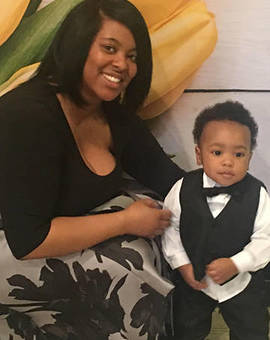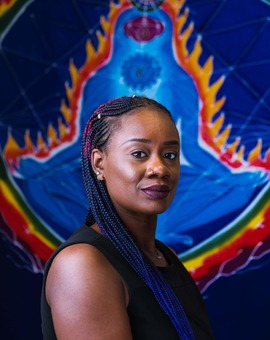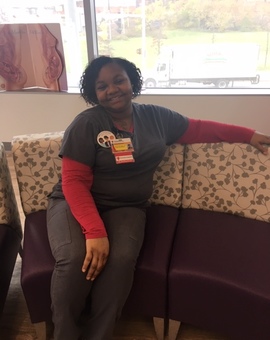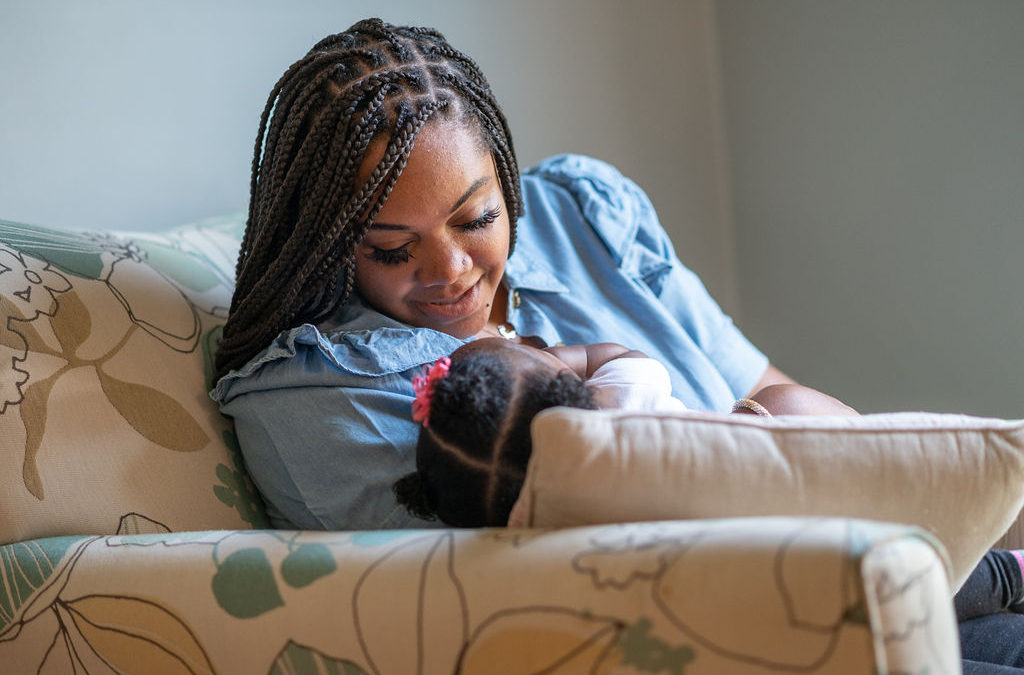
by First Year Cleveland | Jul 26, 2023 | Community Stories
After learning about CenteringPregnancy®, Paige found a supportive group of women to help her through her pregnancy. Today, the friendships remain.
After I learned about CenteringPregnancy at a doctor’s appointment, the thing I really liked about it was that you can bounce ideas and questions off of other women who are expecting at around the same time. A doctor or midwife and nurse practitioner are also there so you get updated, expert medical knowledge too.
In our group, all the women were expecting babies only about two weeks apart. So, it basically felt like we were all going through the same things at the same time. We had a chance to clear up the myths we heard from other people. It made me feel really comfortable.
We had a chance to ask questions. A few people, for example, had “heard” that breastfeeding was really painful, or that formula is healthier, and both of those aren’t true (although breastfeeding can hurt a little at first … but breastmilk provides a lot of benefits to babies).
What I love most about CenteringPregnancy was that it was OK to say if we were wondering if something was normal or find out if some change was happening to other people at the same time. We could relate to things instead of worrying about them. It was very informative.
One thing we noticed was that there were a lot of differences in what people did from generation to generation. Family members sometimes still try to do what they were told to do a long time ago, which was what doctors said then but isn’t recommended anymore. Grandparents and parents were doing their best at the time and using the best information available then, but when you know better, you can do better, with more recent information.
Safe sleep was an important area that has changed. Now we know that babies should be alone, on their back, in a crib (or pack-n-play), and no one should smoke in a house where a baby spends time. They even told us that if moms or dads need a safe place for the baby to sleep, there are programs where you can get free pack-n-plays.
We had a chance to have parents and support people come to join sessions, and they were excited to learn new ways to do things and to hear answers to their questions from medical professionals.
All of the moms were so supportive. We could talk about what did or didn’t work for us during pregnancy and even after our babies were born. I still talk to the moms from my group almost every day! We share pictures of our babies and what they’re doing at each stage now and share ideas for baby food or other things. Women who had a baby 20 years ago or two years ago might forget some of the little details of how they were feeling at each little step, but we are all going through it together right now, at the same time. We really encourage each other.

by First Year Cleveland | Jul 26, 2023 | Community Stories
Christin F. gets daily affirmations that her work with Birthing Beautiful Communities (BBC) is changing lives in Cleveland. The 32-year-old founded the organization in 2014, bringing together a collective of black doulas to combat the city’s dire infant mortality rates among black babies.
Over the past few years, the organization has grown from serving a handful of women to more than 500 in Cuyahoga County. The BBC model improves health outcomes for both mother and baby by providing women with doulas to assist them throughout their pregnancy and their child’s first year of life.
Her focus with First Year Cleveland is understanding the role race and maternal stress play in infant deaths. If you ask Christin about the organization’s five-year plan, there are intentions to expand far past Northeast Ohio. But, for now, the impact is just what the region needs.
I’ve known that I wanted to be a midwife since I was 16. I carry that passion into the work I’m currently doing: making sure women have access to woman-centered care. If that care can’t be delivered by an institution such as a hospital, then there should be a village around the mom to support her as she successfully carries out her pregnancy and labors through the birth of her child. That village should also stay on deck that first year of her child’s life when she so desperately needs it.
When I had my first child (as a student at Kent State University), I was well-supported by my family — both my family at home in Cleveland and my friends at college. We all lived off-campus together, so we were a little family of our own. Now, I certainly had my moments, especially within the first three months, where I struggled during that adjustment to life with a new baby. Nobody talks about that with you. You’re prepared during the pregnancy because you get all this information at your prenatal visits, but after the baby gets here, nobody tells you, “Hey, it’ll be difficult to take a shower or find time to eat.”
I’ve always felt that, as a society, we have not been supportive of reproduction. I just find it to be so odd that systems and policies are not set up to receive families. Even though I didn’t realize my dream of becoming a midwife, I pursued work as a doula, which led me to found Birthing Beautiful Communities.
Birthing Beautiful Communities is designed to take in moms who are at least 16 weeks pregnant — the sooner, the better. First, we assign each mom a perinatal support professional. They do so much more than just attend prenatal visits or the labor and delivery. They are literally embedded into the daily lives of these women, for at least 80 weeks. Their scope is far beyond what people imagine when they think of a doula. We have weekly classes, Sisters Offering Support, for our moms, which are designed to help the women identify what they’re experiencing — stress, depression, anxiety, panic and fear — and give them tools to navigate these experiences or remove them altogether.
The majority of women who experience these things don’t know what to call them. They may say “Oh, I was tripping” or “I’m just mad.” Part of the problem is if they can’t articulate what they’re feeling, then it’s hard to address it. Addressing anxiety is different than addressing fear. It’s important that they identify those feelings, so they can get the proper solution. The best part of this work is seeing women becoming more empowered than when they started off. We see women from all walks of life, all different socioeconomic backgrounds. But the consensus has been that they need this continuous support in their lives. It does increase your self-esteem and your confidence when you know you have someone you can reach out to, who can get you back on track.
I love seeing women come out of a place of hopelessness to a place of optimism, because they have also met other women who are only here to help them and not judge them. Walking into this space for them is a relief. They come here and think, “I can be who I am.”
“This is literally my life’s work. This is what I was born to do. I understand that, I respect that — and I love it.”
When I hear stories from the families, or when we get a call from another state talking about replication, all these little things remind me how necessary our work is. For example, two weeks ago, we got a call from one of the hospitals. They were referring a patient to us. The social worker called 28 agencies before she called ours. Things like this remind me why we exist. This need is why we’re building our own campus with 20 units of short-term housing: the systems are overburdened with people. We haven’t figured out how to build pipelines.
We know that black infant mortality is not a poverty problem — women of all socioeconomic levels and backgrounds are at the same risk. There are two main things that black infant mortality boils down to — racism and patriarchy. Those are the drivers of it. There is not woman-centered care in this country, and women historically have not made the policies that impact families.
Part of the reason we see these higher rates in black communities is a lack of representation in these medical spaces. Our history has prevented us from having opportunities and resources, so now there’s a lack of black doctors and midwives. Across Cuyahoga County, we only have three black midwives who are licensed to catch babies. That’s inequity. Now, black women are saying, “The doctors aren’t listening to us.” They don’t feel comfortable with their providers, but they don’t have many options. That’s because most of the providers are white males. You’ve got to even the playing field, and then we can talk about what’s going on with our policies.
See, there’s a difference between programs and pipelines. Programs are supposed to be short-term. Programs aren’t meant to last 30 years. That’s what we’ve gotten wrong. Pipelines are used to sustain people. You’re supposed to equip people with the tools they need to survive so they have the tools to support their family. If racism and patriarchy aren’t addressed in our programming, then we’re not moving toward a place of equity. Everything else we do is null and void. It’s only going to change what we see today, but not what we see in the future.

by First Year Cleveland | Jul 26, 2023 | Community Stories
CenteringPregnancy facilitator Tyraya D. not only leads sessions but has participated twice as an expectant mother. In the program, expectant moms meet twice a month for two-hour sessions to discuss all things pregnancy and childbirth with a midwife — and each other. Research shows that a group model improves outcomes for both the mother and her baby. Here, Tyraya shares her unique perspective on how Centering enhanced her life, both as a patient and an employee.
I had my first child when I was 14. I was young and it was very, very hard. I was in the eighth grade, and administrators didn’t really want me to be seen, so they kept me in the office, doing work there. I managed to make it through, but it was really hard.
Everything started when I lost my father in fifth grade. After he passed away, I struggled so hard. I was running away from home, giving my mom all types of trouble. I didn’t know anything about sexuality. I was just searching for something to fill that void.
I knew something was wrong, but I didn’t know what was going on with my body. I gave birth on April 13, but I didn’t have my first doctor’s appointment until that February. My life was filled with stares, snickering and whispering. Luckily, my mother was a good support system after it all happened and she helped me through the hardest parts.
“I learned so much in those sessions — everything from how to care for my body during pregnancy to how to alleviate and manage my stress.”
Five years later, when I was pregnant with my second child, I came to one of my prenatal appointments and I saw a flyer for CenteringPregnancy. One of the staff members recommended it to me, saying it would be a great experience. At first, I was hesitant because I wasn’t a people person. Being a young mother, I felt ridiculed a lot of the time. I was dealing with depression and struggling to find an outlet for my stress. I didn’t have a lot of people in my life to turn to. The idea of being with other women, talking about pregnancy and childbirth, was foreign to me.
But I quickly learned that the women in the group were there to support me. I found out that these women were going through the same things I’ve been through. I used Centering as an outlet. I learned so much in those sessions — everything from how to care for my body during pregnancy to how to alleviate and manage my stress. Not only did I have the support, the staff guided me to resources. There were days when I didn’t know where I was going to get things for my child. But, because they directed me to places that could help, it took some of that stress and worry away.
The differences between my first and second births were amazing. After attending Centering with my second, I knew how to handle my labor better. I danced in labor with him. I knew how to manage the contractions with breathing. It was totally different from my first labor. This time, I was better prepared on what to expect. I had an epidural with my first child, but I went natural with my second.
Now that I’m a Centering facilitator, I enjoy every moment — because I’ve been there. I’ve sat in those same seats. I can relate to what they’re going through. I recruit for the program as well. When I hear someone might be interested, I’ll go have a conversation with them to answer any questions they may have. When expectant moms hear about Centering, they think it’s just going to be group discussions, but it’s real prenatal care. You actually get more time with your provider than you would in the traditional setting. The best part is that you’re dealing with women who have something in common.
So many of the women who’ve come through my sessions tell me they have friends who can’t relate. But, in Centering, the other women understand you — and are walking right alongside you.

by First Year Cleveland | Jul 20, 2023 | FYC News and Post
Caring for grandkids is a common role for many grandparents. Whether it is overnight, over a weekend or for an extended period, you will want to make sure the babies are happy and healthy, and that they sleep safely and peacefully.
Many of us have learned how to care for babies from older generations. There are many tips that have been passed down from generation to generation on how to care for children, but it can be difficult to determine if these teachings are outdated or unsafe.
When caring for an infant, learning about safe sleep is very important. Sleep-related deaths are one of the primary causes of infant deaths, and they are largely preventable.
So, before you put your little one to bed, please review these helpful and potentially life-saving tips.
Follow the ABCDs of safe sleep — the easiest way to ensure your grandbaby is safe and sound.
A – Alone
Your grandbaby should sleep alone — not in a bed or on a couch with you, their parents or their siblings. Compared with sleeping in a crib, the overall death rate is more than 40 times higher for babies who sleep with an adult. A great compromise is keeping a portable crib next to your bed — this keeps your grandbaby safe and encourages bonding.
Remember: the same room is okay, but the same bed is not!
B – Back
This one is easy! Just be sure to always place your grandbaby on their back when you put them down for bed. By placing your grandbaby on his or her stomach to sleep, you are placing that baby at increased risk for Sudden Infant Death Syndrome (SIDS). Tummy time is great, but only when it is play time!
C – Crib
Be sure your baby goes to sleep in an empty crib — no toys, blankets, pillows or bumpers. These items pose a major risk for choking or suffocation, especially for babies age 1 and younger, and can increase the risk of SIDS up to five times. And there is no need to use expensive positioning devices or sleep aids! Research has shown that all your grandbaby needs is a firm sleeping surface. Also, be sure to use a crib or bassinet that was manufactured after June 28, 2011, or that is compliant with the Consumer Product Safety Commission’s regulations.
Another way to check if the crib is safe is to make sure that there are no gaps between the sides of the crib and the mattress. You can check this by measuring with two fingers between the two.
Next, never place a crib near any kind of cords. This even includes windows with blinds, curtain cords and baby monitor cords.
Lastly, always make sure the crib has been assembled and installed correctly according to the manufacturer’s directions.
D – Don’t Smoke
Even if you personally do not smoke, others who do that are around your baby should always smoke outside and change their clothes before being around your grandbaby.
That’s right – smoking outside is not enough!
Babies who are exposed to second-hand smoke become more susceptible to developing asthma or having other respiratory problems and are more likely to die from SIDS.
If you smoke, they smoke. Try to quit for the safety of your grandbaby, and encourage others to do so as well!
By following the ABCDs of safe sleeping, you can ensure your grandbaby will wake up, ready for a bright future.
Is it really that easy? Yes, it is! Help us spread the word by sharing the ABCDs of safe sleep with your family and friends! Just a little awareness can go a long way.
Sleep-related deaths are largely preventable.
In 2017 and 2018, there were nearly 30 sleep-related deaths in Cuyahoga County.
SIDS (Sudden Infant Death Syndrome) can sometimes be called “crib death” because it is associated with when the baby is sleeping. But that name is misleading; cribs themselves don’t cause SIDS, the baby’s sleep environment can cause SIDS.
Infants spend more than half their day asleep, which is why this information is crucial to their health. With infants, prevention is key for their care. We’re glad you are choosing to invest in your grandchild’s safety!

by First Year Cleveland | May 14, 2023 | FYC News and Post
(This article originally appeared as an opinion piece in Cleveland.com on May 14,2023)
Mother’s Day is a time to celebrate and thank the strong women that have made each of us who we are today. Being a mom is both a gift and a sacrifice; an affirmation and a challenge; a purpose and a reminder of all that is beyond our control. It’s both creating a community and relying on the support of others to honor a mother’s first instinct — to protect her children.
This Mother’s Day, let’s acknowledge our shared responsibility to provide women what they need to thrive as mothers, from making the decision to become one, through pregnancy and the early years of their children’s lives, to watching their children grow into adulthood.
With our community partners, First Year Cleveland is committed to protecting mothers and families, and to assuring that every baby born in Cuyahoga County celebrates their first birthday.
We work with communities to identify and implement policy and system changes to eliminate barriers to care and create the community conditions necessary for families to thrive. We also provide funding and support to community-based organizations working directly with women and families at risk.
We do this because healthy and supportive communities result in healthy birth outcomes. Mothers want their babies to thrive, and the heartbreak of losing a baby is far too common for a wealthy society like ours.
The uncomfortable reality is that, despite spending far more on health care than other high-income countries, the United States still has one of the highest infant mortality rates: 5.4 per 1,000 live births. Within the United States, Black families are disproportionately affected, with an infant mortality rate 2.4 times greater than that of non-Hispanic white families.
Here in Cuyahoga County, our infant mortality rate is decreasing but still stands at an unacceptable 6.9 per 1,000 live births. The mortality rate for Black babies born in Cuyahoga County is nearly 2.8 times greater than for non-Hispanic whites.
Why do we continue to struggle to mitigate the infant mortality crisis?
Too often we blame mothers for their choices, instead of the social factors that determine health long before a pregnancy. If you benefit from stable housing, if you have reliable access to transportation and resourced schools, if you have stable employment with benefits and child care, you will be healthier than those who don’t. That’s not about personal choices you make, but the unjust policies, history, and social structures that shape daily life.
To create the world as it should be for every mother, take action to protect families – that is the best Mother’s Day gift you can make.
· Educate yourself, friends and family on the impact of racism (not race) and implicit bias on infant mortality.
· Support legislation and policies that address equity, including the state budget proposals for The Early Childhood Mental Health Consultation and Help Me Grow evidence-based home visiting program; Ohio House Bill 7, The Strong Foundations Act, a package of maternal and infant health provisions; and the federal Black Maternal Health Momnibus Act bills, once they are reintroduced in the 118th Congress.
· Do not support legislation that negatively impacts human, reproductive, and civil rights.
· Prioritize community voice and expertise when making decisions about programs, services, or policy changes.
· Celebrate the joy of birth, motherhood and families. Our city is full of brilliant, strong, creative and committed families building the communities they deserve.
A mom’s first instinct is to protect and care. This Mother’s Day, let’s commit to doing the same for moms, expectant mothers, and the future generation of mothers. Commit to lending your expertise. Your time. Your heart. We need passionate people to make a difference.
Angela Newman-White has almost 20 years of public health experience in maternal and child health. In January 2023, she joined First Year Cleveland as their new executive director.





